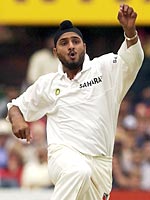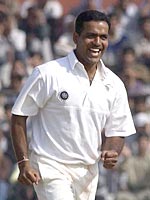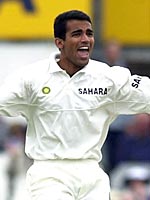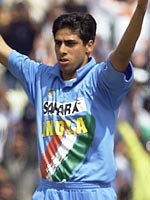Figuring out our ODI bowlers
Michael Higgins
With the cricket World Cup just a few months away, now is the last chance to make changes in India's bowling for ODI's. It would be good to look at the bowling performances of the full-time and part-time bowlers and make some comparisons. To make the comparison more relevant, I looked at each bowler's last 20 matches, (if he bowled in at least 20 matches).
The first table is for full-time bowlers. The list is restricted to bowlers who have bowled at least in 12 matches and at least one of the last 50 ODI's that India has played.
| Player | M | Bw avg | econ | wa econ | RA/10 | E | G | A | B | w pct |
| Harbhajan | 20 | 24.31 | 4.17 | 3.89 | 40.1 | 20% | 15% | 40% | 25% | 72% |
| Khan | 20 | 24.21 | 4.83 | 4.18 | 44.2 | 15% | 25% | 45% | 15% | 76% |
| Mohanty | 20 | 25.38 | 4.52 | 4.16 | 44.6 | 10% | 35% | 30% | 25% | 50% |
| Agarkar | 20 | 24.66 | 5.20 | 4.41 | 47.3 | 10% | 30% | 20% | 40% | 56% |
| Nehra | 20 | 33.68 | 4.45 | 4.68 | 48.6 | 10% | 25% | 40% | 25% | 75% |
| Harvinder | 16 | 25.38 | 5.33 | 4.55 | 48.9 | 6% | 25% | 44% | 25% | 60% |
| Prasad | 20 | 32.44 | 5.20 | 5.07 | 51.8 | 5% | 25% | 35% | 35% | 50% |
| Joshi | 20 | 39.65 | 4.73 | 5.13 | 52.3 | 5% | 15% | 30% | 50% | 50% |
| Kumble | 20 | 47.32 | 4.67 | 5.33 | 53.5 | 0% | 20% | 45% | 35% | 68% |
| Srinath | 20 | 36.13 | 5.36 | 5.38 | 54.6 | 5% | 10% | 50% | 35% | 42% |
| Avg FT | 20 | 29.33 | 4.70 | 4.57 | 47.4 | 10% | 24% | 36% | 31% | 76% |
| Avg PT | 20 | 44.04 | 5.50 | 5.83 | 58.3 | 0% | 8% | 21% | 39% | 76% |
The first four columns are self-explanatory. The fifth column "wa econ" is wicket-adjusted economy. It is an attempt to combine bowling average and economy into a single bowling statistic. I used the Duckworth-Lewis rain adjustment table to estimate how many runs are lost on average due to a lost wicket. Of course it varies during the course of the match. On average, a lost wicket costs 13 runs. It isn't more than that because teams tend to lose wickets when they have "wickets to burn".
 The sixth column "RA/10" is runs allowed per ten overs. This is different than wicket-adjusted economy in that the bowler is penalized for not bowling a full ten overs on average. If a bowler bowls eight overs, then a part-time bowler (and usually a mediocre bowler) must bowl another two overs. I didn't make any adjustment for rain-affected matches so every bowlers "RA/10" number is high, but the bias is small and consistent for everyone.
The sixth column "RA/10" is runs allowed per ten overs. This is different than wicket-adjusted economy in that the bowler is penalized for not bowling a full ten overs on average. If a bowler bowls eight overs, then a part-time bowler (and usually a mediocre bowler) must bowl another two overs. I didn't make any adjustment for rain-affected matches so every bowlers "RA/10" number is high, but the bias is small and consistent for everyone.
The next four columns rate the bowlers' last 20 matches, (or all their matches if less than 20), into four categories: "E" for excellent-a "RA/10" of 20 or less, "G" for good-a "RA/10" of between 20 and 40, "A" for average-a "RA/10" of between 40 and 60, and "B" for bad-a "RA/10 of more than 60. The last column is winning percentage (excluding non-results). There should be a correlation between good bowling and winning, but it also might indicate the strength of the opposition.
Let us first look at the numbers for the six regular full-time bowlers: Harbhajan Singh, Zaheer Khan, Ajit Agarkar, Ashish Nehra, Anil Kumble, and Javagal Srinath.
Harbhajan is clearly a world-class bowler. He combines great economy with a great bowling average. A high proportion of his performances are excellent.
Zaheer Khan is the most consistent bowler India has. Only 15% of his bowling performances are bad, and he almost always gets one or more wickets. His economy rate is not as good as Harbhajan's but he bowls a lot at the death and if the part-time bowlers and Anil Kumble do not get wickets (which is frequent) then he will go for runs. His good bowling average is another by-product of bowling at the death.
Ajit Agarkar is a mixed bag. His bowling average is excellent and he is a useful bat at number eight. His economy is mediocre, but not as bad as some other bowlers. However, Ajit is very inconsistent-40% of his bowling performances are bad. That might explain why his winning percentage is low.
Ashish Nehra looks very promising as a third seamer. He has a good blend of economy and bowling average. He is prone to the one bad over and he needs to work on being more consistent by the World Cup.
Many people including Sunil Gavaskar have been saying the Anil Kumble is past his prime and should be dropped from one-dayers. His numbers certainly indicate a real problem. His economy is okay but he isn't getting wickets at all. It has been a very long time since he had a match winning bowling performance in an ODI. His style of bowling will probably be ineffective on South African wickets. On the other hand, he was one of the top five bowlers in the world for many years and he is too young to be "over the hill" so maybe he can turn it around. He really needs some great bowling performances in the ODI's against West Indies to cement his place in the World Cup team.
Like Kumble, many commentators, including Gavaskar, have been saying that Javagal Srinath is past his prime. His numbers certainly look bad. It doesn't help that he is a poor fielder and weak batsman as well. In his defence, one could point out that he has opted out of easy series like Zimbabwe and played in difficult series like South Africa and Australia, whose batsmen can ruin any bowler's figures. Like Kumble, he really needs to come up big against the West Indies. The problem for India is this: can they afford to keep giving chances to older players like Kumble and Srinath at the expense of grooming a newer prospect like Nehra or Yohannan?
The big surprise for me was the person who is number three on the list: Debashish Mohanty. He was actually bowling very well when he was dropped three years ago. He made a brief comeback about a year-and-a-half ago and bowled very well in one match and poorly in some others. It is very hard to tell how well he would do if he were given another chance. He has World Cup experience and even some World Cup success, so he should be on the selector's short list of World Cup prospects. However, Mohanty never seems to get the respect he deserves.
Harvinder Singh has bowled in a handful of ODIs over the years with mixed results. His bowling average is excellent but his economy is poor. His last match was a loss against Kenya in which he bowled poorly, and that might have ended his career.
Venkatesh Prasad has enormous ODI experience and World Cup experience, so he might get another chance if the selectors give up on Srinath. Prasad's numbers look very mediocre and he is very inconsistent-he has had three really awful bowling performances in his last twenty including a 0/73 in seven overs in India's humiliating 245 run loss to Sri Lanka at Sharjah two years ago.
 Sunil Joshi is a long shot to return to international cricket. He is relatively old, he is a spinner and unlikely to go to South Africa, and his numbers don't look very good. He does bat well so he might get some interest as an all-rounder, but Yuvraj Singh is a good spinning all-rounder so the team probably won't take another one.
Sunil Joshi is a long shot to return to international cricket. He is relatively old, he is a spinner and unlikely to go to South Africa, and his numbers don't look very good. He does bat well so he might get some interest as an all-rounder, but Yuvraj Singh is a good spinning all-rounder so the team probably won't take another one.
The last two rows correspond to the average bowling performances for full-time and part-time bowlers in the last 20 matches. As you can see, there is a big difference in the average bowling performances of full-time and part-time bowlers. Of course, there is an enormous difference in batting ability also.
Here is a list of some of India's part-time bowlers. To some extent, every player is a bowler because everyone bowls occasionally (except the wicketkeeper). The following list just includes the part-timers who bowled in at least one recent match in the last 25 that India has played. I also included Robin Singh just because so many fans think he was the best all-rounder India has had in the last decade.
In each case, I included only matches that the part-timer actually bowled; I included up to 20 matches if he bowled in 20 matches. Since, part-timers tend to bowl every other match, in some cases the 20 matches stretched back a year and a half ago. There is a danger that the current form of the part-timer is not reflected by an average from such a long time period. However, if you take a smaller sample-like 10 matches-then the average tends to be noisy and it may not really represent the part-timer's ability.
| Player | m | avg | econ | wa econ | E | G | A | B |
| Bharadwaj | 9 | 19.19 | 4.95 | 3.55 | 0% | 56% | 22% | 22% |
| Yuvraj | 20 | 32.53 | 4.81 | 4.84 | 5% | 20% | 35% | 40% |
| Badani | 6 | 37.00 | 4.93 | 5.15 | 0% | 0% | 83% | 17% |
| Ganguly | 20 | 46.45 | 5.13 | 5.64 | 0% | 10% | 35% | 55% |
| Tendulkar | 20 | 43.50 | 5.28 | 5.65 | 5% | 5% | 40% | 50% |
| Sehwag | 20 | 48.89 | 5.05 | 5.66 | 0% | 15% | 25% | 60% |
| Bangar | 4 | 44.00 | 5.28 | 5.67 | 0% | 25% | 50% | 25% |
| Sodhi | 14 | 73.00 | 4.74 | 5.85 | 0% | 7% | 50% | 43% |
| Robin | 20 | 81.40 | 4.86 | 6.04 | 0% | 10% | 40% | 50% |
| Mongia | 5 | 34.00 | 7.12 | 6.35 | 0% | 20% | 0% | 80% |
| Avg PT | 20 | 44.04 | 5.50 | 5.83 | 0% | 8% | 21% | 39% |
Again, I will first look at the current members of the India team and then look at the others. Note that all part-time bowlers have a high percentage of bad bowling performances because they frequently only bowl for two or three overs and if the bowler doesn't get a wicket, it is likely to rate a "B".
Yuvraj Singh looks like a very good bowling prospect. He has the best combination of bowling average and economy of any of the current members of the team. Yuvraj has only bowled in only 8 of the last 17 matches (and only 30 overs) and while his bowling average over that time is good (31.16) his economy has been bad (6.23) over those matches. Still, I think that Ganguly should bowl Yuvraj more overs, because he takes wickets. I also believe that he will get his economy back down if he can bowl more overs.
 It is remarkable how similar the wicket-adjusted economy for Ganguly, Tendulkar, Sehwag and Bangar are. Ganguly has been the most important part-time bowler for India in the last three years. His last ten performances have been mostly bad, with only three wickets at 75 apiece. He needs to turn his bowling around or else India will have to think about another part-time seamer.
It is remarkable how similar the wicket-adjusted economy for Ganguly, Tendulkar, Sehwag and Bangar are. Ganguly has been the most important part-time bowler for India in the last three years. His last ten performances have been mostly bad, with only three wickets at 75 apiece. He needs to turn his bowling around or else India will have to think about another part-time seamer.
India has several part-time spinners to choose from. Besides Yuvraj, both Tendulkar and Sehwag are used frequently. Tendulkar and Sehwag are mediocre bowlers, but they occasionally come up with a match winning performance, like Sehwag's 3/25 in five overs against South Africa in the recent ICC Champion series. Dinesh Mongia has been used as a part-time bowler from time to time but he probably isn't a bowler.
Among the part-timers who are not part of the current team, Vijay Bharadwaj has the best bowling figures by far. He hasn't played much and his bowling numbers maybe just a fluke. He also may be ill suited to bat seventh. He played in one ODI against Zimbabwe a few months back and scored a duck and gave up 32 runs in just four overs, and that performance may have ended his international career. But anyone with numbers like his probably should get another chance, and he has played very well against South Africa (but not in South Africa).
Hemang Badani may get another chance in the West Indies series if the selectors decide to drop Mongia. Badini hasn't bowled much and he may develop into a good bowler but would probably end up more like another Sehwag.
Besides Ganguly, the other part-time seam bowlers are Sanjay Bangar, Reetinder Singh Sodhi, and Robin Singh. Bangar will probably get one more chance against West Indies. His problem is more his batting: he is just not suited to the short form of the game. Sodhi would be one of the few players who could do well as a number seven batsman, but he really isn't a bowler. Robin Singh's numbers show why he was dropped.
The next list is a list of potential all-rounders. India may decide to replace Dinesh Mongia with a bowler who can also bat. Ideally, this extra bowler would be a seamer so that India would have a four seam plus Harbhajan attack. I'm fairly certain that India will toy with this combination in the upcoming West Indies ODI series. The following list shows the bowling and batting average plus strike rate for some potential all-rounders.
In this case, the batting average and strike rate is based on the last 20 matches that the player had an innings (not necessarily complete). So the bowling averages and batting averages are compiled over a different set of matches.
| Player | M | bw avg | econ | wa econ | bt avg | SR |
| Yuvraj | 20 | 32.53 | 4.81 | 4.84 | 35.0 | 94 |
| Sodhi | 17 | 73.00 | 4.74 | 5.85 | 27.9 | 74 |
| Bharadwaj | 10 | 19.19 | 4.95 | 3.55 | 27.2 | 70 |
| Robin | 20 | 81.40 | 4.86 | 6.04 | 20.8 | 64 |
| Agarkar | 20 | 24.66 | 5.20 | 4.41 | 20.1 | 105 |
| Joshi | 20 | 39.65 | 4.73 | 5.13 | 18.1 | 105 |
| Harbhajan | 20 | 24.31 | 4.17 | 3.89 | 12.4 | 85 |
Yuvraj Singh, Ajit Agarkar, and Harbhajan Singh are already part of the ODI team. Yuvraj's batting in the last twenty matches has been phenomenal. He fills the role of a spinning all-rounder, so he makes Vijay Bharadwaj or Sunil Joshi's selection very unlikely.
 Agarkar has been very good as a number eight batsman in the last two years and he could walk into the number seven role without much difficulty. His very high strike rate indicates that he throws his wicket away for quick runs-which is exactly what a number eight should do. He may bat with a much higher average if he batted up the order, but I doubt he could handle batting at number three.
Agarkar has been very good as a number eight batsman in the last two years and he could walk into the number seven role without much difficulty. His very high strike rate indicates that he throws his wicket away for quick runs-which is exactly what a number eight should do. He may bat with a much higher average if he batted up the order, but I doubt he could handle batting at number three.
Harbhajan Singh's is one of the few full-time bowlers with any batting ability in the short form of the game. He might do reasonably well as a number eight, but he isn't as good as Agarkar.
Reetinder Singh Sodhi bats reasonably well for a number seven although not nearly as well as Mohammad Kaif, but Kaif may bat too well to be a number seven batsman. The problem is, Sodhi adds essentially nothing to the bowling attack.
I included Robin Singh's numbers just for comparison. Note that his batting average and strike rate in his last 20 matches were not even as impressive as Ajit Agarkar's.
The last table is a table of new prospects. These are bowlers that bowled less than ten matches and have bowled in one of the last 100 ODI's. Some of these might get another chance, but one look at their numbers and you realize why they were dropped.
| Player | M | avg | econ | wa econ | R/10 | E | G | A | B | W pct |
| Yohannan | 3 | 24.40 | 6.10 | 4.80 | 51.17 | 33% | 0% | 0% | 67% | 67% |
| Kumaran | 8 | 38.67 | 5.52 | 5.62 | 56.45 | 13% | 13% | 38% | 38% | 50% |
| Shukla | 3 | 94.00 | 4.95 | 6.21 | 60.43 | 0% | 0% | 67% | 33% | 33% |
| Bhandari | 1 | 37.50 | 7.50 | 6.85 | 68.50 | 0% | 0% | 0% | 100% | 0% |
| Sarandeep | 2 | 83.00 | 6.38 | 7.33 | 67.80 | 0% | 0% | 0% | 100% | 0% |
| Karthik | 1 | N/A | 5.88 | 7.83 | 74.10 | 0% | 0% | 0% | 100% | 100% |
| Avg New | 18 | 42.72 | 5.78 | 5.97 | 59.14 | 11% | 6% | 28% | 56% | 44% |
Obviously, any bowler who was dropped after only just a few matches would have bad bowling numbers. Luckily for India, Zaheer Khan was not dropped after his failure against New Zealand in the ICC Knockout two years ago. If India persisted with any of these bowlers, there is a good chance that they would be okay after a year or two. But India doesn't have a year or two.
This table shows that there is essentially no chance that some new bowler will come in and lead India to the World Cup championship. If India does go with four seamers in the World Cup, they will have to choose them from the first table. Khan, Nehra and Agarkar select themselves but who would be the fourth seamer? If it is Srinath, then India will need to hope that he can turn his ODI career around in a hurry. But India needs a plan B. Mohanty did reasonably well in the last World Cup and India should take another look at him.
Editor's note: Rediff believes that like its own editorial staffers, readers too have points of view on the many issues relating to cricket as it is played.
Therefore, Rediff provides in its editorial section space for readers to write in, with their views. The views expressed by the readers are carried as written, in order to preserve the original voice.
However, it needs mentioning that guest columns are opinion pieces, and reflect only the feelings of the individual concerned -- the fact that they are published on Rediff's cricket site does not amount to an endorsement by the editorial staff of the opinions expressed in these columns.
Mail Michael Higgins